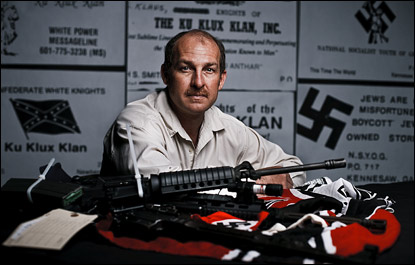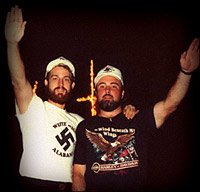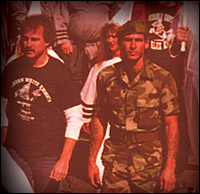Hate Group Infiltrator Mark Carpenter Remembers Time Undercover Protesting SPLC
For 18 months, an undercover agent worked in the revolutionary racist underground. Now, Bart McEntire can finally tell his story
"White power!"
Nearly 200 racist skinheads, white-robed Klansmen, and other white supremacists chanted racist slogans as they marched through downtown Montgomery, Ala., on a sunny Saturday in March 1991. As they passed the headquarters of the Southern Poverty Law Center, Mark Carpenter — the leader of a new hate group called the White Reich — yelled out, "[SPLC co-founder] Morris Dees is a racist Jew and a queer!"
He sounded like a bigot brimming with hatred. But Carpenter had a secret. His true identity was Special Agent Bart McEntire of the Bureau of Alcohol, Tobacco and Firearms. For months, he'd been preparing to go undercover to investigate the skinhead underworld in Birmingham, Ala., which at the time was among the most active and violent in the country. To establish his credentials, McEntire had asked an ATF informant to drop his cover identity's name in white supremacist circles. He'd scoured newspaper articles for details about unsolved robberies and bombings he could claim to have committed. And he'd arranged for the Lexington County Sheriff's Department in South Carolina, where he'd begun his law enforcement career, to conjure a record showing that Mark Carpenter had been arrested for illegally possessing explosives.
Finally, he and the White Reich were making their public debut in Montgomery. It was the beginning of an 18-month undercover investigation that took McEntire and fellow ATF agents from Klan rallies throughout the Southeast, to skinhead gatherings deep in the woods of rural Alabama, to a military base in western Georgia. The investigation helped solve a series of murders and contributed to the successful prosecution of more than a dozen white supremacists on charges ranging from illegal possession of firearms to homicide and manslaughter. It also uncovered a ring of soldiers at Fort Benning who were supplying hate groups with stolen military weapons, highlighting the ongoing dangers of white supremacists infiltrating the military.
Now, on the eve of his retirement from the ATF after a 23-year career, McEntire is for the first time telling the story of his double life as Mark Carpenter. His account reveals some of the tactics he used to penetrate the inner circle of a criminal subculture in which young minds were twisted to believe that brutal murders of unarmed black homeless men constituted the first battles of a fast-approaching race war. This war was to be fought in part with guns and bombs stolen from the armories of the Zionist Occupied Government, the enemy otherwise known as the United States.
The following account is based on extensive interviews with McEntire and other local and federal law enforcement officials; state and federal court documents; Associated Press articles; and McEntire's unpublished memoir, Not for Self But Others.
Making Friends
The first contact McEntire developed was Cecil Bradley, a member of the Alabama Knights of the Ku Klux Klan. They'd marched together in Montgomery. Several nights a week, McEntire drove to Bradley's house in nearby Hueytown, Ala., in his ATF undercover vehicle: a blue and gray GMC pick-up with mud grip tires and four-wheel drive. They'd sit on Bradley's front porch, sometimes drinking beer. McEntire commiserated with the Klansman about how minorities were taking over the world. Soon, Bradley was singing the praises of Mark Carpenter and the White Reich to other Birmingham-area Klansmen.
One evening, Bradley's 9-year-old son, Phillip, gave McEntire a straight-armed Nazi salute.
"What are you?" Bradley asked.
"A national socialist," the tow-headed boy replied.
"What's that?
"A Nazi."
"Where does Adolf Hitler live?"
"In my heart."
Bradley beamed. He often trotted out his son to repeat his allegiance to Hitler. The exchange always made McEntire queasy. Yet he also saw him play tenderly with his disabled daughter and learned that Bradley had lost his own father as a child.
One night a couple months after they'd started hanging out, Bradley confided in a low voice that a longtime Klansman was organizing a militant extremist group some 20 miles southeast of Birmingham on Oak Mountain. He was a true warrior for the white race, Bradley said. McEntire had to meet him.
Meeting the Boss
As the light faded in his suburban Birmingham neighborhood several days later, McEntire pulled on an old Soldier of Fortune T-shirt, a ragged pair of jeans and heavy work boots. He rubbed his hands, arms and clothing with a gooey mixture of dirt, engine grease and water. He tossed a shovel, rake and lumber into the blue and gray pick-up truck.
He also armed himself with his ATF-issued 9 mm Sig Sauer semi-automatic pistol. "Only a German gun is suitable for killing our enemies," he'd tell his new friends.
After picking up Bradley at his home, they headed south toward rural Shelby County. The truck bounced along a rutted dirt road that snaked its way through thick woods until a ramshackle house appeared in a clearing on a hill. As he turned into the driveway, McEntire saw Bill Riccio, who rented the so-called "WAR House" that was named after his hate group, the White Aryan Resistance.
"Great," McEntire recalls thinking. "All I need is to meet a Klansman holding an ax."
But Riccio was simply cutting some trees for the night's cross lighting. As he launched into a tirade about the superiority of the white race, kids arrived for the night's festivities. They greeted McEntire with a Nazi salute and shouted "Heil Hitler!"
"Heil Hitler," McEntire replied.
Riccio told McEntire that he needed to keep a low profile while he was still on parole. He had racked up several felony convictions, including firearms and civil rights violations.
The sounds of gunfire often reverberated as kids took part in rifle target practice. The group was trying to obtain its goal of a separate nation for whites not only through political tactics — such as distributing flyers near shopping centers and schools — but also by teaching followers how to engage in armed combat.
Yellow Laces
On April 18, 1992, the ATF Birmingham Field Office received a call from the Birmingham Police Department. Just before 4 a.m. that morning, a Birmingham police officer on patrol had responded to an apparent fatal industrial accident.
At the scene, the officer saw that a railroad train had run over a man, whose left foot was severed. But the officer also observed a trail of blood leading from the man's bedroll beneath a bridge, where homeless people often slept, to his body some 20 feet away. The man's face was cut and he had a stab wound in his chest. The victim was black.
Meanwhile, about 20 minutes earlier, two officers patrolling the nearly empty streets had seen someone throw an object through the passenger side window of a blue Chevy Malibu not far from the railroad tracks. They stopped to retrieve what turned out to be a 12-inch hunting knife. It was dripping with blood.
The occupants of the vehicle included three young men who were members of Riccio's skinhead network.
Four months earlier, on Christmas Eve, another homeless man was beaten to death beneath the same bridge. Yet another was found unconscious on the road below. It appeared that he'd jumped from the overpass to escape the same fate.
The violence continued. On April 16, 1992, just two days before the victim with the severed foot was discovered, a group of homeless black men were sleeping beneath the bridge when several young white men drove up in a red truck. One of them stabbed a man in the back. He spent a week recovering in a hospital.
The spate of violence sharpened the focus of McEntire's investigation. It also prompted him to enlist the help of Dave Behrend, a six-foot-two, 245-pound ATF agent who assumed the role of bodyguard for the leader of the White Reich.
During McEntire and Behrend's first visit to Riccio's after the discovery of the severed-foot murder victim, the atmosphere was unusually subdued. They noticed two skinheads slip outside. They were Louis Oddo, a hulking thug, and Adam Galleon, a skinny kid who sported a white supremacist tattoo on his head. The two undercover agents watched them whisper together intently. Neither Oddo nor Galleon had been in the car when the four skinheads were arrested on April 18. The two agents glanced at one another. They were both thinking the same thing: the whispering skinheads were involved in the murders and attacks.
At a Birmingham-area rally several weeks later, Behrend overheard another skinhead exclaim, "You ain't shit until you earn your yellow shoelaces."
Some skinheads wear yellow laces in their combat boots to signal that they've killed someone. McEntire remembers thinking the skinheads were murdering homeless men "for a damned pair of yellow shoelaces."
Big Chops
Three months after the April murder, Riccio invited McEntire to a Klan rally in northern Alabama's Morgan County. As McEntire and another undercover agent got ready to leave the WAR House, a skinhead — nicknamed Chops because he sported sideburns extending from his ears to his mouth — asked if he could ride with them.
Chops usually smelled bad and enjoyed talking about his sex life. It was going to be a long ride.
As they headed north on I-65, the lush scenery on either side of the highway unspooled like ribbon. And so did Chops.
"Bum bashing, man, that's what it was," McEntire remembers him saying. "Those n------ did not have a chance."
Chops was referring to the night on Christmas Eve when skinheads killed the homeless black man with a baseball bat and chased another off the overpass. He began naming the skinheads who'd participated, including Galleon and Oddo — the two that McEntire and Behrend had seen whispering together at the WAR House.
Soon he began revealing details about other incidents, including the second murder. Clearly, he wanted to impress the White Reich, which had developed a fearsome reputation and was often fending off requests from white supremacists eager to join.
Military Neo-Nazis
Around the same time that Chops unwittingly gave up several fellow skins for murder and attempted murder, McEntire's undercover operation took another dramatic turn. He was sitting on a Klan leader's porch talking about explosives with a couple of skinheads when one of them, Ken Collins, asked if they wanted to see something.
Collins scurried around the back of the house. When he returned, he proudly displayed a Model M116A1 hand grenade simulator, used in the military to teach people how to operate hand grenades.
"You know how to really hurt someone?" he asked, according to McEntire's notes.
McEntire smiled encouragingly.
"Wrap some BBs around it."
McEntire wanted to get it away from Collins, but the skinhead was reluctant to part with his prize. Finally, he agreed to trade the simulator for a six-pack of Budweiser.
Collins explained that he'd gotten the simulator from some soldiers at Fort Benning, just over the Alabama line in Columbus, Ga. The soldiers were stealing military equipment from the base and selling it to white supremacist groups.
"We could really use some of that stuff," McEntire said. "I need to meet those guys."
Collins said he'd work on it.
But before Collins set up the meeting, McEntire's cover was blown when an HBO producer who'd been working on a documentary about Riccio, and who'd met McEntire when he was at the WAR House in character, spotted him at the ATF's offices in Birmingham. Despite her swearing not to reveal his identity, McEntire's superiors forbade him from continuing to work undercover, though he was still allowed to run the operation.
Then Collins made contact and said he'd arranged a meeting with the soldiers. McEntire knew that if he didn't go along, Collins might suspect it was a setup. So McEntire instructed the three undercover agents who'd be driving to Columbus to act decisively when they picked up Collins at the WAR House. "Two of you grab him, put him in the car, lock the door, give him a beer, and don't let him out," he remembers telling them.
As predicted, Collins was upset when he didn't see McEntire in the car.
Behrend offered an excuse for McEntire's absence and explained that the other two men were the White Reich's explosives guys.
Collins yelled racial slurs out the window of the ATF's black Camaro on the way to the soldiers' home, a run-down trailer on the outskirts of Ft. Benning. Balled-up fast-food wrappers, beer cans and liquor bottles littered the floor.
The soldiers — Michael Stacy, Mark Abbott and Keenan Zimmerman — were skittish. Because the white power band Skrewdriver was blasting from a stereo, Behrend called Zimmerman into a bathroom so their conversation would be picked up by the agent's body wire.
"Listen, brother," Zimmerman said, according to Behrend's notes, "if we get busted for this shit, you guys are going to a f------ country club prison camp somewhere, and we're going to f------ Leavenworth to do hard time busting big rocks into smaller rocks."
Eventually, Zimmerman handed over a single grenade simulator. They'd have to return if they wanted explosives to blow up synagogues and black churches.
Two days later, the undercover agents and Collins once again headed to Fort Benning. When they arrived at the trailer, the soldiers drew a map showing where they'd stowed the explosives.
After the agents tried unsuccessfully to find the cache in the darkness, the soldiers — heavily armed with machine guns — brought them to a dirt road surrounded by pine forest and gestured toward a nearby tree.
"They're going to hose us down, man," Behrend recalls saying to another agent.
But instead Behrend safely retrieved a canvas duffel bag with an artillery simulator, flares and rounds of tracer ammo.
Leaving Columbus, they stopped at a gas station. An exhausted Behrend, who's now a supervisory criminal investigator with the Department of Homeland Security, held the door for an older black woman. She glared at him. For a moment he was confused. Then he saw his reflection in the plate glass; he was wearing a T-shirt emblazoned with a swastika and the words "white power."
The Unmasking
On Aug. 10, 1992, McEntire strode into the Hugo L. Black U.S. Courthouse in downtown Birmingham. McEntire was the sole government witness scheduled to testify at a bond hearing for Bill Riccio and Ken Collins. Both men had been arrested on federal weapons charges, along with Bradley.
McEntire had forsaken his worn jeans and white power T-shirt for a suit and tie. As he entered the courtroom, Collins looked up in shock, while Riccio's eyes burned with contempt.
McEntire spotted Bradley — the Klansman who'd been his first contact — in a blue T-shirt sitting behind one of the attorneys. McEntire had gotten to know Bradley well. He felt that Bradley could have had a different life, if only there'd been someone to show him the way.
He slowly walked over to Bradley and put his hand on the man's shoulder.
"Cecil," he remembers saying, "it will be all right."
Bradley gazed at him with fear and surprise. He shook his head.
McEntire walked away. He couldn't think of anything else to say.
Prison Times
Riccio pleaded guilty to federal firearms violations and was sentenced to four years in prison. He served less than two years of his sentence, resumed his white supremacist activities upon his release, and continued to recruit youths into the movement, albeit on a much reduced scale. Collins and Bradley also pleaded guilty to firearms violations and received sentences of five months of imprisonment and three years' probation, respectively.
Four skinheads were convicted of murdering the homeless black men and sentenced to between 25 years and life in prison. Two others were convicted of manslaughter. One, who wielded a knife, received the maximum penalty of 20 years. The other, who drove a getaway car, was sentenced to nine months in prison and five years probation.
U.S. soldiers Zimmerman and Abbott were court-martialed, dishonorably discharged, and sentenced to five- and four-year prison terms, respectively.
McEntire and his family left Birmingham shortly after he testified against Riccio. A wanted poster showing his face was plastered on white supremacist websites. He never worked undercover again.
When he looks back on his year-and-a-half living as Mark Carpenter, he remembers snapshots of images from nights at the WAR House and white power rallies. At one rally, when it came time for the grand finale — the lighting of a 30-foot high swastika — the skinheads realized they'd forgotten the diesel fuel. McEntire and another agent drove from one convenience store to another in rural Alabama, but none of them carried it. They finally bought two quarts of oil and mixed it with five gallons of gasoline.
When they pulled into the entrance of the Klan-owned farm, they handed over the gas can without revealing that the liquid inside was fast-burning gasoline. The skinheads doused the burlap-covered swastika with the concoction. As they lit the swastika, it caught fire with a tremendous whoosh that sent the white supremacists fleeing. McEntire smiled as the flames consumed the symbol of hate.





